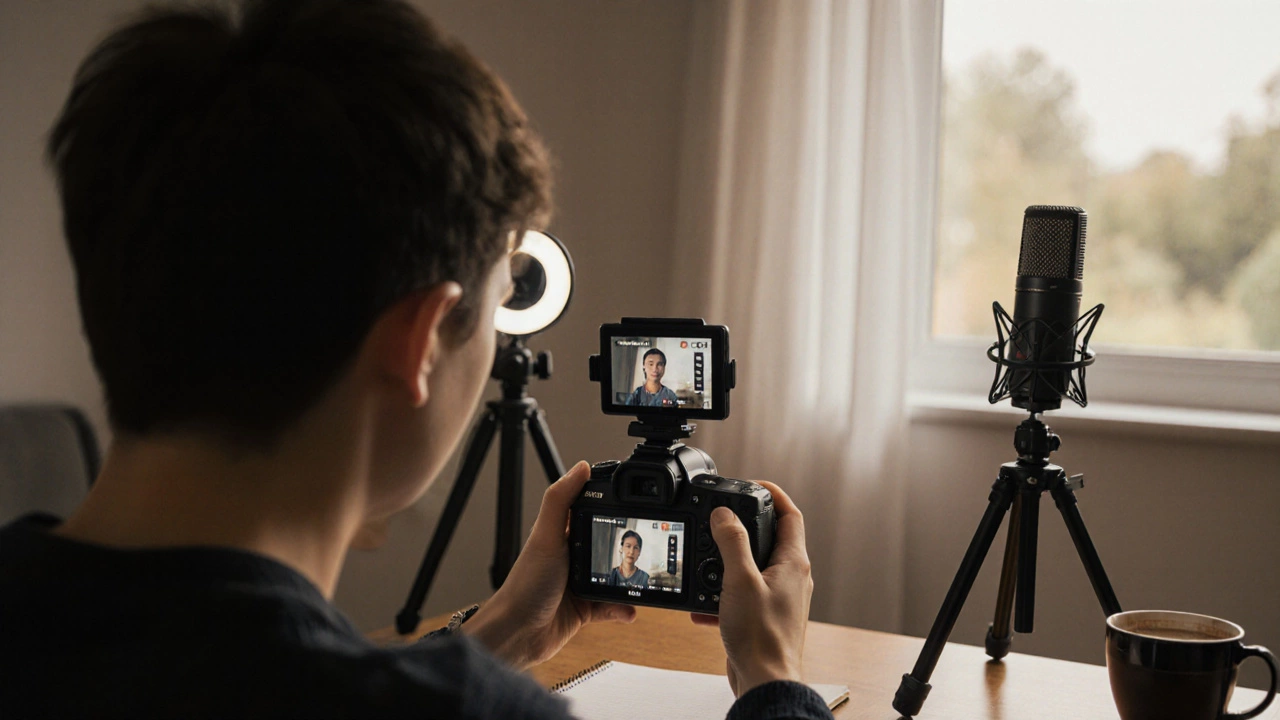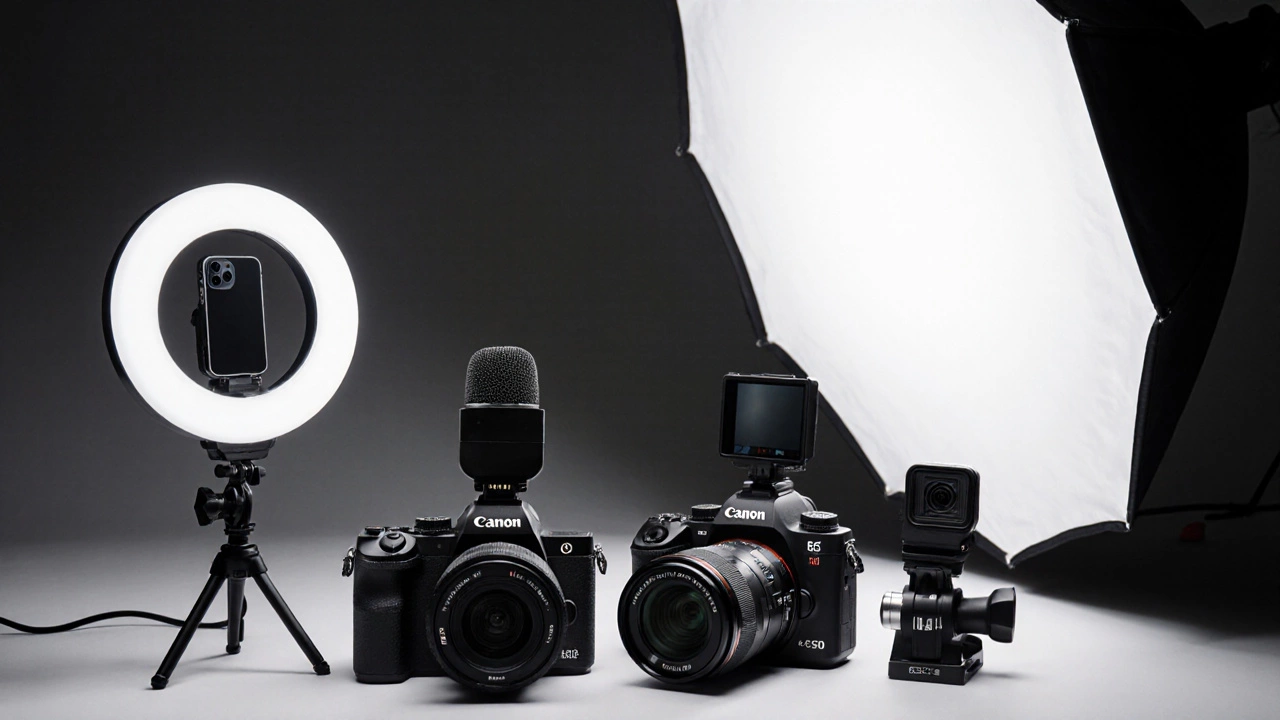What Camera Do Most YouTubers Use in 2025?
 Nov, 18 2025
Nov, 18 2025
YouTube Gear Calculator
Build Your YouTube Setup
Get the right gear for your content type and budget
Recommended Setup
Enter your budget and content type to see your customized YouTube gear recommendation.
If you’re starting a YouTube channel, one of the first questions you’ll ask is: What camera do most YouTubers use? It’s not just about looking professional-it’s about getting the right balance of quality, ease of use, and price. The truth is, there’s no single camera everyone uses, but a few models keep showing up in videos from creators with millions of subscribers. And if you’re trying to decide which one to buy, knowing what’s actually working for others saves you time, money, and frustration.
Canon EOS R50: The Quiet Favorite
Right now, the Canon EOS R50 is the most common camera you’ll see in new YouTuber setups. It’s not the most expensive, but it’s packed with features that matter for video. It records 4K at 30fps, has excellent autofocus that locks onto faces and eyes-even when you’re moving around-and it’s light enough to hold for hours without your arms giving out. Most creators use it with a simple lavalier mic and a cheap ring light, and the results look clean and professional.
Why the R50? Because it doesn’t require a degree in camera settings. You turn it on, point it at yourself, and it just works. The flip-out screen lets you frame yourself easily. The built-in mic is decent for casual use, and if you want better sound, plugging in a $20 USB mic makes a huge difference. YouTubers like Emma Chamberlain and MrBeast’s team have used similar Canon models, and the R50 is the budget-friendly version of that same DNA.
Sony ZV-E10: The Audio Powerhouse
If you care more about sound than looks, the Sony ZV-E10 is the camera to watch. It’s a mirrorless camera with a large sensor, interchangeable lenses, and one standout feature: a built-in directional mic that cuts out background noise better than most external mics on cheaper cameras. You don’t need to buy a separate mic right away-though most serious creators eventually do.
What makes the ZV-E10 popular isn’t just the mic. It’s the color science. Sony’s picture profile gives skin tones a natural glow without needing heavy editing. That’s a big deal if you’re editing on your phone or using free software. YouTubers in the beauty, tech, and education niches love this camera because it looks good out of the box. And since it uses Sony E-mount lenses, you can upgrade later without replacing the whole system.
GoPro Hero 12: For the Active Creator
Not everyone sits in front of a desk. If your content involves walking, biking, traveling, or doing things outside, the GoPro Hero 12 is the go-to. It’s tiny, waterproof, and shoots rock-steady 4K video even when you’re running or jumping. Creators like Casey Neistat and travel vloggers use it for dynamic shots that would be impossible with a bulky DSLR.
The downside? It doesn’t have a flip screen you can use for framing yourself like a traditional vlogging camera. You have to rely on voice commands or an app to start recording. But if you’re doing on-the-go content-cooking outside, hiking, street interviews-the GoPro is unmatched. Many YouTubers pair it with a small external mic and use the R50 or ZV-E10 for talking-head shots.
iPhone 15 Pro: The Hidden Contender
Yes, the iPhone 15 Pro is used by a surprising number of YouTubers. Not because it’s a camera company’s product, but because it’s incredibly easy to use. It shoots 4K HDR video, has great stabilization, and lets you edit and upload straight from your phone. You don’t need a laptop to start posting.
Channels like Marques Brownlee and Linus Tech Tips use iPhones for quick updates, behind-the-scenes clips, and even full-length reviews. The key is lighting. Natural light or a $30 LED panel makes the iPhone look professional. If you’re just starting out and don’t want to invest $500 in gear right away, this is your best bet. You can always upgrade later.

What You’re Really Buying: A System, Not Just a Camera
Most people think they’re buying a camera. But what you’re really buying is a system: camera + mic + light + tripod + editing software. The camera is just the starting point.
For example, if you buy a Canon R50 but use the built-in mic in a noisy room, your video will sound terrible. No amount of camera quality fixes bad audio. That’s why almost every YouTuber you see uses an external mic-usually a Rode VideoMicro or a DJI Mic Mini. They cost $50-$100, but they make your voice sound clear, crisp, and professional.
Lighting is just as important. A $25 ring light or a softbox from Amazon makes your face look even and reduces shadows. A $15 tripod keeps your shot steady. And free software like DaVinci Resolve or CapCut handles editing just fine.
The most successful YouTubers don’t have the most expensive gear. They have the right combination of tools that fit their style. If you’re doing talking-head videos, go for the R50 or ZV-E10. If you’re filming on the move, the GoPro wins. If you’re testing the waters, start with your iPhone.
What to Avoid
Don’t fall for the trap of buying a camera just because it has the highest megapixel count or 8K video. Most YouTubers never use 8K. It creates huge files, drains your storage, and makes editing slower. You don’t need 4K at 60fps unless you’re doing slow-motion action shots.
Avoid cameras that don’t have a flip screen. You need to see yourself while recording. If the screen doesn’t flip or rotate, you’ll be guessing your framing-and that leads to awkward cuts and wasted time.
Stay away from cameras that require you to plug in a computer to change settings. You want something you can turn on, adjust with buttons, and start recording in under 10 seconds. Complexity kills consistency.
Real-World Examples
Look at three popular creators:
- Ali Abdaal uses the Sony ZV-E10 with a Rode VideoMic Go. He edits on his iPad.
- Thomas Frank started with an iPhone 12, then moved to the Canon R50. He uses natural light from his window.
- Casey Neistat uses the GoPro Hero 12 for movement and a Canon R5 for studio shots.
They all use different gear. But they all prioritize: clear audio, good lighting, and simple editing. The camera is just the tool that holds it all together.

What Should You Buy Right Now?
Here’s the simple breakdown:
- Under $400: Start with an iPhone 15 or iPhone 14. Add a $50 mic and a $20 ring light. You can make great content.
- $500-$800: Go for the Canon EOS R50. It’s the sweet spot for serious beginners.
- $800-$1,200: Get the Sony ZV-E10 if you want better color and audio out of the box.
- On the move? GoPro Hero 12 + a phone for talking-heads.
There’s no magic camera. The best one is the one you’ll actually use every week. If you buy something too complicated, you’ll put it back in the box. Pick something simple, reliable, and easy to grow with.
Final Thought: Your Content Matters More Than Your Gear
People don’t subscribe to your camera. They subscribe to your voice, your ideas, your energy. A $2,000 camera won’t fix boring content. But a $300 camera with a clear message, consistent uploads, and real personality? That’s what grows a channel.
Start with what you have. Improve one thing at a time. Focus on showing up. The gear will follow.
Do YouTubers use DSLR cameras anymore?
Most YouTubers have moved away from DSLRs. They’re heavier, slower to autofocus in video mode, and don’t have flip screens optimized for vlogging. Mirrorless cameras like the Canon R50 and Sony ZV-E10 are lighter, faster, and designed for video. DSLRs are still used by some filmmakers, but for YouTube, they’re outdated.
Is 4K necessary for YouTube videos?
No, but it helps. YouTube plays 1080p videos fine, but 4K gives you more flexibility. You can zoom in during editing without losing quality, and it future-proofs your content. Most creators shoot in 4K and export in 1080p. It’s not about resolution-it’s about having room to edit.
Can I use a webcam for YouTube?
You can, but it’s not ideal. Webcams like the Logitech C920 are okay for live streams or Zoom calls, but they lack manual controls, have poor low-light performance, and don’t support external mics. If you’re serious about YouTube, a dedicated camera with a flip screen and mic input is a better long-term investment.
What’s the best budget camera for beginners?
The Canon EOS R50 is the best budget camera for beginners in 2025. It costs around $550 with a kit lens, records great 4K video, has reliable autofocus, and a flip screen. It’s simple enough for first-time users but powerful enough to grow with you. If you’re on a tighter budget, an iPhone 15 with a cheap mic and ring light works better than most budget cameras.
Do I need a microphone if my camera has a built-in mic?
Yes. Built-in mics pick up everything: fan noise, traffic, your breathing. Even the best ones sound flat and distant. A $50 lavalier mic like the Rode VideoMicro or DJI Mic Mini makes your voice sound clear, intimate, and professional. Audio is the #1 reason people stop watching videos-not video quality.
Should I buy a camera with a flip screen?
Absolutely. If you’re recording yourself, you need to see your framing. A flip screen lets you adjust your position, check lighting, and make sure you’re not cutting off your head. Without it, you’re guessing. Most successful YouTubers use cameras with fully articulating screens-this isn’t optional.
Next Steps
Start by asking yourself: What kind of videos do I want to make? Talking head? On-the-go? Tutorials? Then pick the simplest tool that fits. Don’t overthink it. Buy one good mic. Get a cheap light. Start filming. Your first video won’t be perfect-and that’s okay. The best YouTubers didn’t start with fancy gear. They started with a plan, a camera they could use, and the courage to hit record.